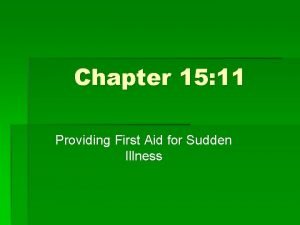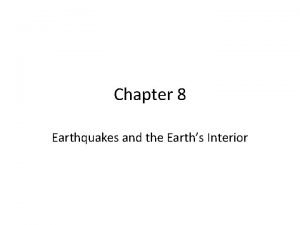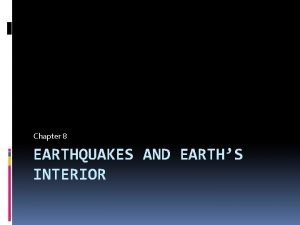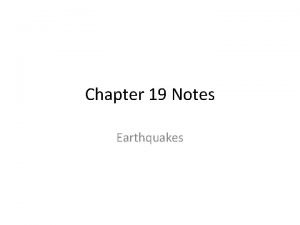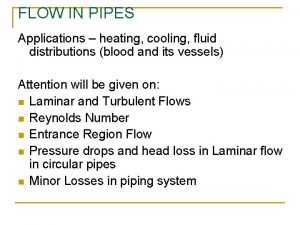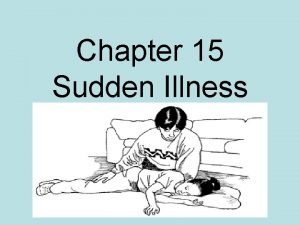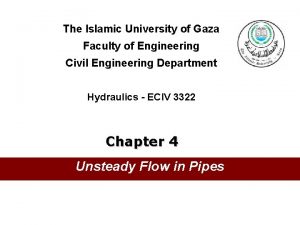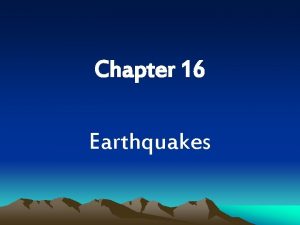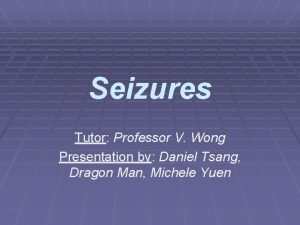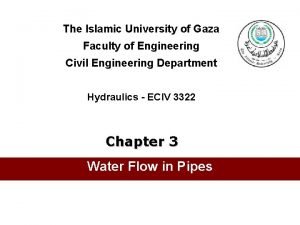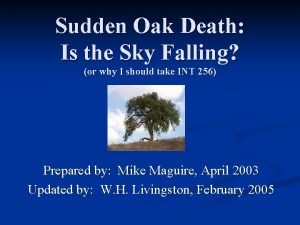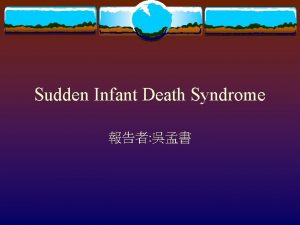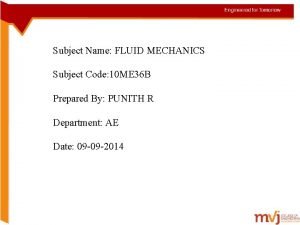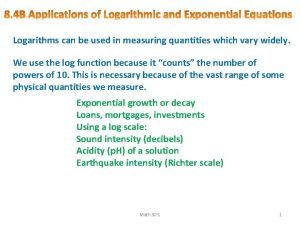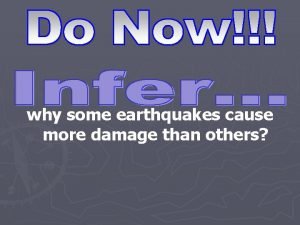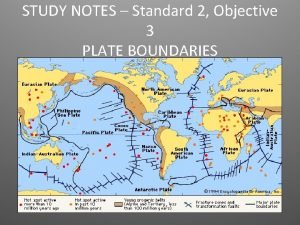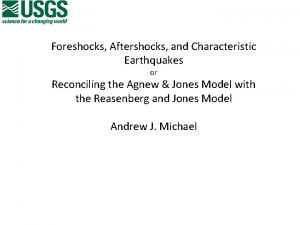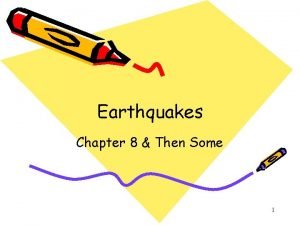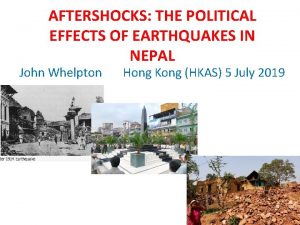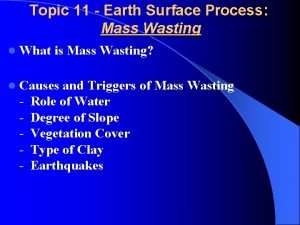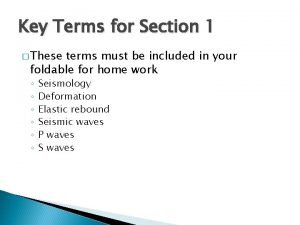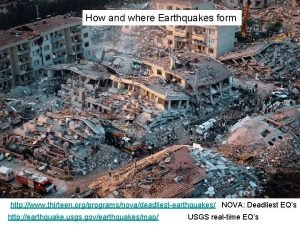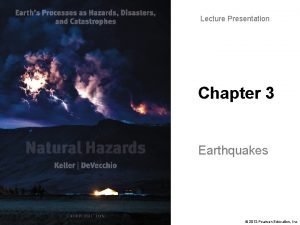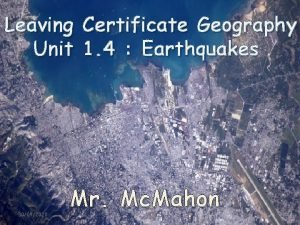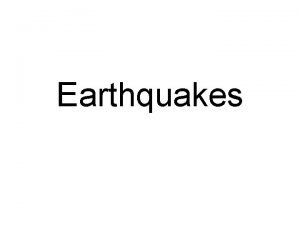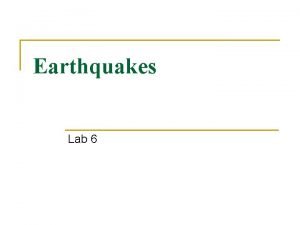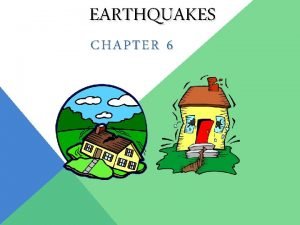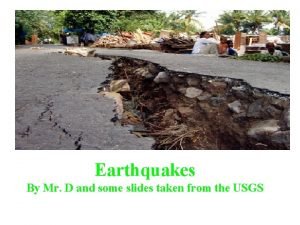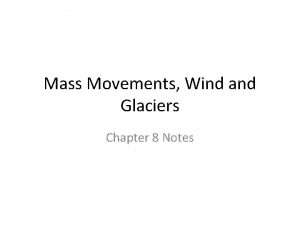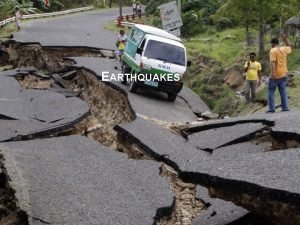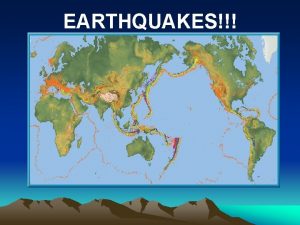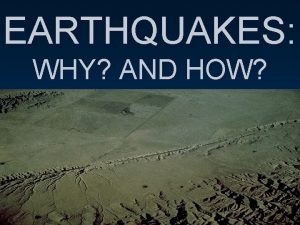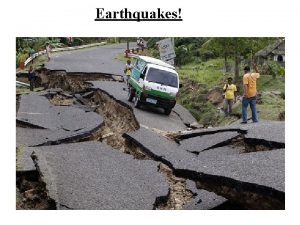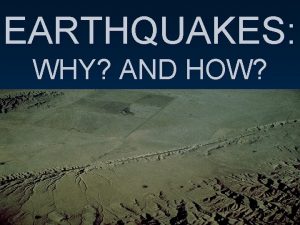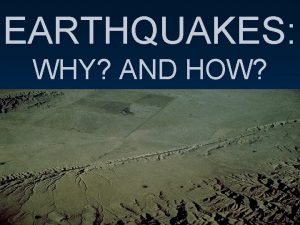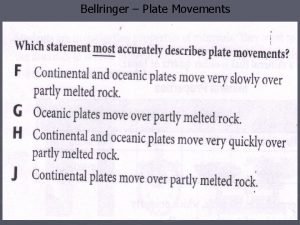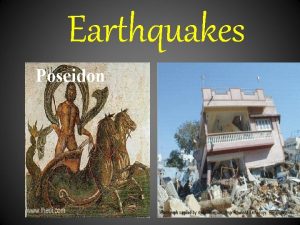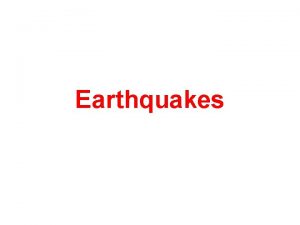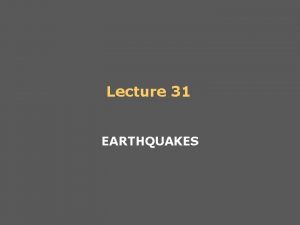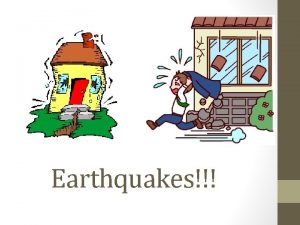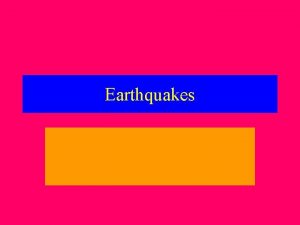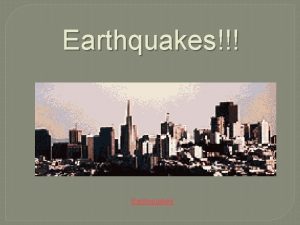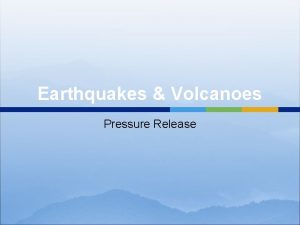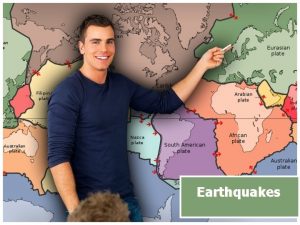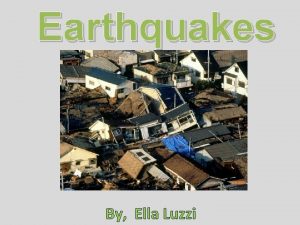Earthquakes Chapter 12 Earthquakes are sudden movements of


























































- Slides: 58

Earthquakes Chapter 12

Earthquakes are sudden movements of the earth caused by the release of energy when rocks along a fault move.


Faults may remain locked for years and then suddenly slip, rebound, and slip again regaining their stable position. Shock waves (seismic waves) radiate through the earth from the point of this slip. This is the elastic rebound theory.




The point at which the fault slips, is called the focus of the quake. The point on the earth’s surface above the focus is called the epicenter.

The depth of the focus may vary: • 90 percent of all quakes are shallow focus quakes (above 70 km). These are the most destructive since deeper focus quakes dissipate their energy underground. • Intermediate focus (70 -300 km) • Deep focus (300 -650 km) occur in subduction zones.



Earthquake body waves travel through the body of the earth. They are of two types: § P-waves (primary or compression waves) move particles back and forth along the direction of the wave. They are the fastest of the earthquake waves moving fastest through rigid materials. § S-waves (secondary or shear waves) move particles side to side in the direction of the wave. They can only travel through solids.



Surface waves move along the surface of the earth from the effect of the P and S waves. They are the slowest waves and do the most damage. They are of two types: Love waves move the ground side to side and in a vertical motion. n Raleigh waves cause the surface to roll. n




Seismic waves have been used to map the internal layers of the earth: • In 1909 Andrija Mohorovicic noted changes in the speed of seismic waves at about 30 km beneath the continent. This speed change was due to the difference in density between the mantle and the crust and has been used to map the internal earth. • S-wave shadow zones have also been used to build a model of the internal earth.





Studying Earthquakes Section Two

Earthquakes may occur in three general plate tectonic environments: u Convergent oceanic environments u Divergent oceanic environments u Continental environments




At some plate bondaries, there are numerous closely spaced faults called fault zones.


Earthquakes may occur away from plate boundaries. Fault zones have formed in the earth’s past and then buried under millions of years of sediment. Isostatic adjustments than cause the faults to slip. A powerful quake in New Madrid, Missouri in 1811 -1812 was just this type


The study of earthquakes and seismic waves is called seismology. The study of seismology has been extended into located earthquakes and mapping and explaining the processes of the internal earth.

Vibrations traveling through the ground are detected and recorded using a seismograph. The modern seismograph has three components: up-down, north-south, and east-west. The graph of the waves is called a seismogram.


• A seismogram is a record of the ground shaking recorded by a seismograph. • The P waves travel fastest through the Earth so they arrive at a seismograph first, followed by the S waves and lastly by the surface waves. • The figure above is the seismogram of the 1989 Loma Prieta earthquake recorded at a seismograph in Kongsberg, Norway, 8400 km (about 5, 200 miles) away. • •


Scientists are able to use triangulation to accurately locate the epicenter of a quake.

The measure of the strength of an earthquake is called magnitude. It is determined by measuring the amount of ground motion in the quake and assigned a rating on the Richter Scale. A Richter Scale rating of 3 would be thirty times as powerful as a rating of 2.

Moment magnitude is a more modern method that is often used that takes into account: • Size of the area that moves • Average distance that the fault blocks move. • Rigidity of the rocks in the fault zone.


Before the mathematic calculation of magnitudes, the size of the quake was termed intensity. It was determined by the damage of the quake and placed on the Mercalli Scale. Intensity depends on: • • • The earthquake’s magnitude Distance to the epicenter The affected area The local geology The earthquake’s duration The human infrastructure.




Earthquakes and Society Section 3

Movement of the ground during earthquakes seldom results in death and injury. Instead, death results from the collapse of buildings and structures and flying objects. Other dangers include: Landslides Fires Explosions Floods

A sudden drop in the ocean floor during an earthquake may set a tsunami into motion. A tsunami is a fast moving wave that increases in height as it approaches land.



Most buildings are not constructed to withstand the swaying motion of earthquakes and fall from foundation failure. Other buildings may be built on unstable rock formations and experience soil failure (liquidification).


People who live near active faults should take some earthquake precautions: • Before an earthquake, keep canned food, bottled water, a flashlight, batteries, and a radio on hand. You should practice your evacuation routes and know where the water and gas shutoffs are for your house. • During an earthquake, stay away from heavy furniture and stand in a doorway if possible. When outside, move to open areas away from buildings and power lines. • After a quake, beware of broken glass, gas leaks, fires, and downed power lines.

Scientists are studying a variety of changes in the earth that would make accurate earthquake forecasts possible. • Seismic gaps areas along faults where strong earthquakes have occurred in the past but few have happened recently. • Some earthquakes are accompanied by foreshocks. • Changes in the magnetic and electrical properties of rocks may occur. • Animal behavior changes.

Unfortunately, most earthquake predictions have been unreliable.



 Mikael ferm
Mikael ferm 10 examples of axial movements
10 examples of axial movements Chapter 17:4 providing first aid for shock
Chapter 17:4 providing first aid for shock 16:11 providing first aid for sudden illness
16:11 providing first aid for sudden illness Chapter 8 section 1 what are earthquakes
Chapter 8 section 1 what are earthquakes Chapter 8 earthquakes and volcanoes
Chapter 8 earthquakes and volcanoes Chapter 8 earthquakes and earth's interior
Chapter 8 earthquakes and earth's interior Chapter 19 earthquakes
Chapter 19 earthquakes Chapter 8 earthquakes and earth's interior
Chapter 8 earthquakes and earth's interior Chapter 19 earthquakes
Chapter 19 earthquakes Sudden bullets
Sudden bullets Sudden oak death map
Sudden oak death map Gradual contraction loss coefficient
Gradual contraction loss coefficient Head loss formula for sudden contraction
Head loss formula for sudden contraction Sudden illness definition
Sudden illness definition The valve closure in a pipe is said to be gradual when
The valve closure in a pipe is said to be gradual when The sudden release of energy stored in rocks causes a(n)
The sudden release of energy stored in rocks causes a(n) Sadlier vocabulary workshop level d unit 1
Sadlier vocabulary workshop level d unit 1 Sudden fiction meaning
Sudden fiction meaning Dante yaş 35
Dante yaş 35 Sudden painless loss of vision
Sudden painless loss of vision Ahsan mukhtar
Ahsan mukhtar Sudden attack projetista
Sudden attack projetista Leda and the swan allusion
Leda and the swan allusion Sudden painless loss of vision
Sudden painless loss of vision Derivation of chezy formula
Derivation of chezy formula Sudden oak death map
Sudden oak death map Sudden light by dante gabriel rossetti
Sudden light by dante gabriel rossetti What is sudden infant death syndrome
What is sudden infant death syndrome Fluid mechanics subject code
Fluid mechanics subject code How many syllables in mountains
How many syllables in mountains Sudden death proc
Sudden death proc In what section of earth do earthquakes happen?
In what section of earth do earthquakes happen? Btn earthquakes
Btn earthquakes Positive effects of earthquakes
Positive effects of earthquakes Http://earthquake.usgs.gov/earthquakes/map/
Http://earthquake.usgs.gov/earthquakes/map/ A large crack in the earth formed by a river or earthquakes
A large crack in the earth formed by a river or earthquakes Why some earthquakes cause more damage than others
Why some earthquakes cause more damage than others Frequent earthquakes in an area may indicate *
Frequent earthquakes in an area may indicate * Earthquakes
Earthquakes Quiz 1 earthquakes
Quiz 1 earthquakes Earthquakes
Earthquakes Mass wasting
Mass wasting Plastic deformation earthquakes
Plastic deformation earthquakes Why do earthquakes occur
Why do earthquakes occur Epicenter of earthquake
Epicenter of earthquake Pearson education
Pearson education Richter scale range
Richter scale range Seismograph
Seismograph Example of diastrophism
Example of diastrophism Causes of earthquake in points
Causes of earthquake in points Whats the main cause of earthquakes
Whats the main cause of earthquakes Types of fault
Types of fault Examples of mass movement
Examples of mass movement A typical sequence of movements in a classical concerto is
A typical sequence of movements in a classical concerto is Extrapyramidal movements
Extrapyramidal movements All volleyball hand signals
All volleyball hand signals Setting up chess board
Setting up chess board Social movement examples
Social movement examples



